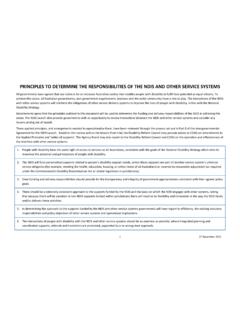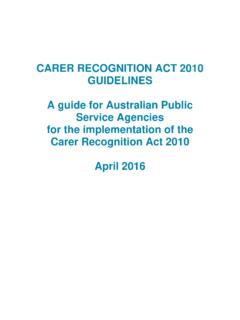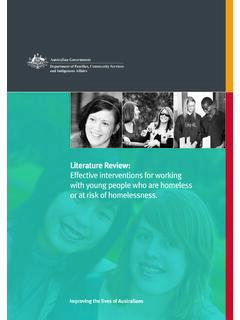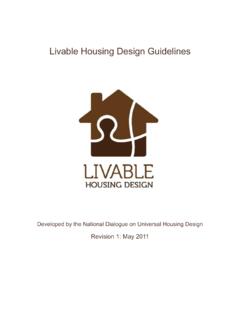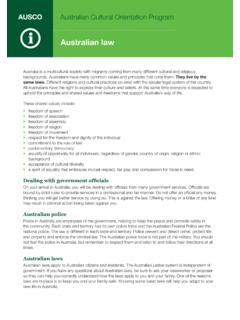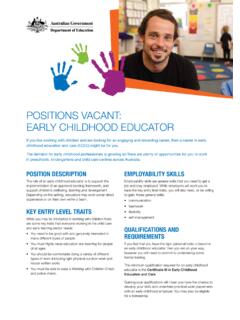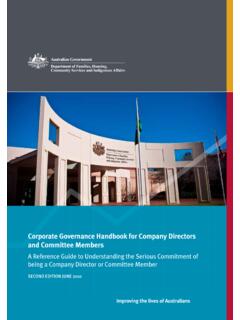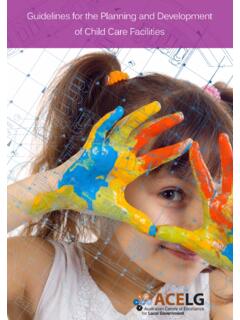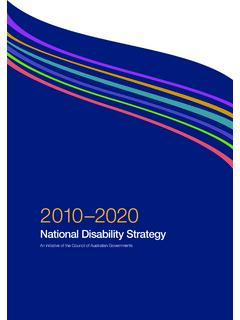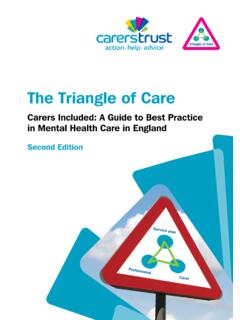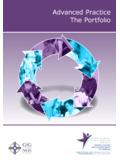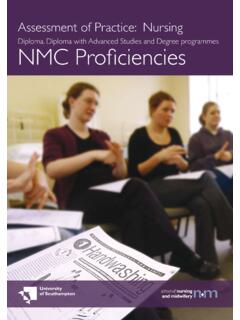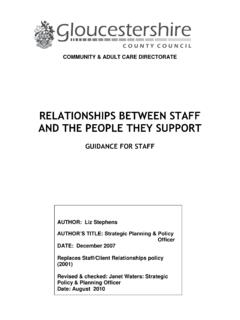Transcription of National Standards for Disability Services
1 National Standards for Disability Services DSS Version December 2013 2 National Standards for Disability Services Copyright statement All material is provided under a Creative Commons Attribution-NonCommercial-NoDerivs Australia (CC BY-NC-ND AU) licence. The details of the relevant licence conditions are available on the Creative Commons website (accessible using the links provided), as is the full licence The document must be attributed as the National Standards for Disability Services . 3 4 Contents Introduction .. 6 An overview of the National Standards .. 7 Six National Standards .
2 7 Definitions .. 7 The framework for the National Standards .. 8 Promoting person-centred approaches .. 9 The Human rights principles .. 9 The Quality Management principles .. 10 Standard One: .. 11 Rights .. 11 Rights for people .. 11 Outcomes for people .. 11 Standards for service .. 11 Indicators of Practice .. 12 Standard Two: .. 13 Participation and Inclusion .. 13 Rights for people .. 13 Outcomes for people .. 13 Standards for service .. 13 Indicators of Practice .. 14 Standard Three .. 15 Individual Outcomes .. 15 Rights for people .. 15 Outcomes for people .. 15 Standards for service.
3 15 Indicators of Practice .. 16 Standard Four .. 17 Feedback and Complaints .. 17 Rights for people .. 17 Outcome for people .. 17 Standard for service .. 17 5 Indicators of Practice .. 18 Standard Five .. 19 Service Access .. 19 Rights for people .. 19 Outcome for people .. 19 Standard for service .. 19 Indicators of practice .. 20 Standard Six .. 21 Service Management .. 21 Rights for people .. 21 Outcome for people .. 21 Standard for service .. 21 Indicators of practice .. 22 National Standards for Disability Services Summary Table .. 23 6 Introduction The National Standards for Disability Services ( National Standards ) will help to promote and drive a nationally consistent approach to improving the quality of Services .
4 They focus on rights and outcomes for people with Disability . The National Standards were first produced in 1993. They have been revised to reflect current language, philosophies and service models, particularly the move towards individualised supports and person-centred service delivery. In 2010, people with Disability , their family & carers , service providers and advocates provided feedback on the 1993 National Standards with comprehensive consultation led by the Disability Studies and Research Centre of the University of New South Wales. Consultation focused on awareness and use of the Standards , language, meaning, relevance and utility.
5 Based on this feedback, the National Standards were revised with a draft version tested nationally in 2012. People with Disability , family, friends & carers , service providers, advocacy organisations and quality bodies informed the development of the revised National Standards . As well as this version, there is also an Easy English version of the National Standards . There are a number of companion resources including an Evidence Guide, a Conversation Tool and Stories to support awareness and application of the National Standards . In time, additional resources will be developed 7 An overview of the National Standards Six National Standards There are six National Standards that apply to Disability service providers.
6 1. Rights: The service promotes individual rights to freedom of expression, self-determination and decision-making and actively prevents abuse, harm, neglect and violence. 2. Participation and Inclusion: The service works with individuals and families, friends and carers to promote opportunities for meaningful participation and active inclusion in society. 3. Individual Outcomes: Services and supports are assessed, planned, delivered and reviewed to build on individual strengths and enable individuals to reach their goals. 4. Feedback and Complaints: Regular feedback is sought and used to inform individual and organisation-wide service reviews and improvement.
7 5. Service Access: The service manages access, commencement and leaving a service in a transparent, fair, equal and responsive way. 6. Service Management: The service has effective and accountable service management and leadership to maximise outcomes for individuals. Definitions This section lists a number of common terms and describes how they are used within the National Standards . Continuous improvement the term continuous improvement describes the ongoing effort of an organisation to improve Services , systems, processes or products to maximise benefits for its clients. The process of continuous improvement relies on evidence-based information to support the organisation s success in achieving its goals and outcomes.
8 This also means adapting to changing needs of the community or people using Services . Cultural competency the term cultural competency describes individuals and organisations with a set of behaviours, attitudes, knowledge, skills, practices and processes which enable effective work in cross-cultural settings. It is more than cultural awareness. It means that individuals and organisations are proactive, rather than responsive, regarding cultural diversity to ensure effective and relevant service delivery or supports. Dignity of risk the term dignity of risk promotes each person s autonomy and self-determination to make their own choices, including the choice to take some risks in life.
9 Family, friends and carers the term family, friends and carers recognises the importance of connection with family and friends, as well as the caring roles 8 played by family, friends and carers . The word family is inclusive of partners or significant others as well as parents, siblings, children and other family members. Individual the term individual is used to describe the person who uses a service or support. This is primarily people with Disability who use a service or support. The word individual may also mean a family member or carer, for example, in the case of people using respite Services .
10 Individual is used instead of words such as consumer , client or service user . Outcomes the term outcomes describes the impact or result of a service or support, such as an improvement in an individual s wellbeing. Outcomes can be distinguished from outputs . Outputs describe the delivery of Services or supports, such as the provision of training. Outcomes can be short-term (such as an individual being involved in service planning) through to long-term (such as an individual finding employment after completing a course). Minimal restriction the term minimal restriction' or 'minimal intervention recognises any restrictions on choice and control should be minimal and evidence based.
